
№38 Naunton Collection, 1912.
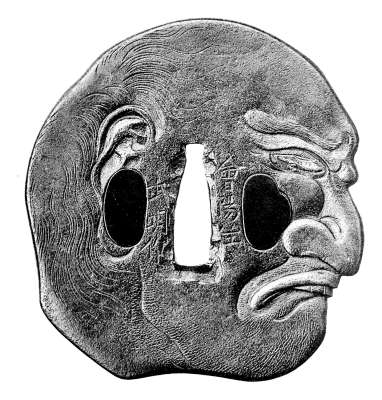
№2729 Naunton Collection, 1912.

№236 Hawkshaw Collection, 1910.
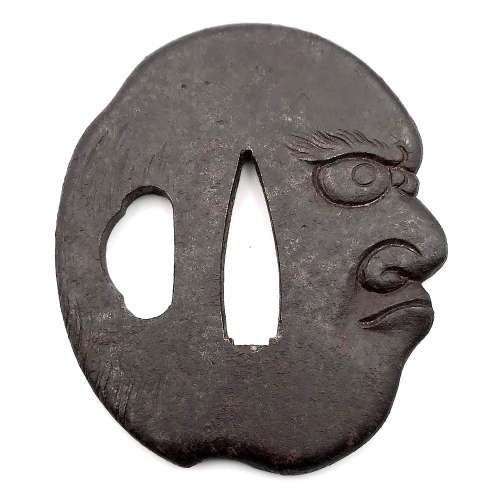

№38 Naunton Collection, 1912.

№2729 Naunton Collection, 1912.

№236 Hawkshaw Collection, 1910.

Size: 75.0 x 74.4 x 3.6 (center), 5.0 (rim) mm.
The plant Marsilea (paddy plant, denjiso), common names include water clover and four-leaf clover because the long-stalked leaves have four clover-like lobes and are either held above water or submerged. In The elements of Japanese design by John W. Dower, this motif is listed under the numbers 634-35 Paddy Plant (denjiso). Obviously, as a four-leaf clover it is an auspicious symbol. The four leaves radiate out as the shape of the kanji 田 (romaji 'ta'), which means 'rice paddy'. This symbol may be used as a family crest (mon), and this would be the most probable explanation of the sukashi on this tsuba.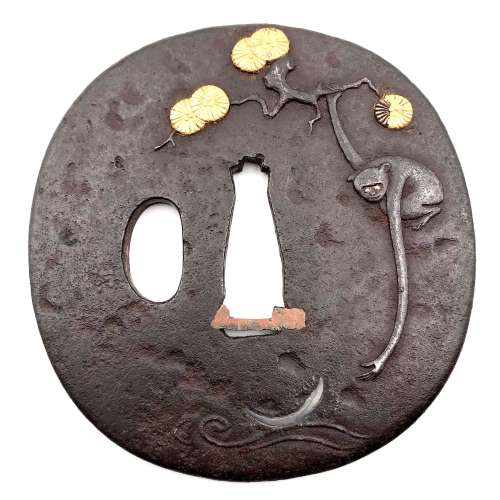
Iron tsuba of slightly elongated round form carved and inlaid in gold and shibuichi with a long-armed monkey hanging from a pine tree branch reaching for the reflection of a crescent moon in the stream. A pine tree carved with details inlaid in gold on the reverse. The design seems to be inspired by Kaneie work (Compton III, p. 10, №6a; Tsuba no bi, 1947, p. 33, №56).
Dimensions: 76.8 x 74.2 x 3.6 mm. Mid-Edo period. Unsigned.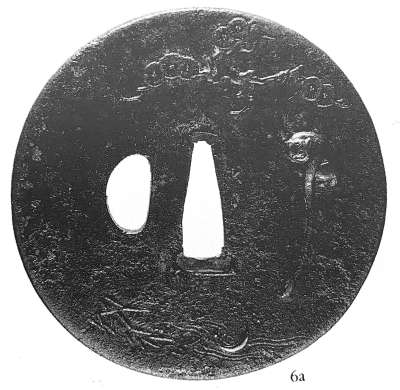
Compton III, p. 10, №6a

Tsuba no bi, 1947, p. 33, №56.
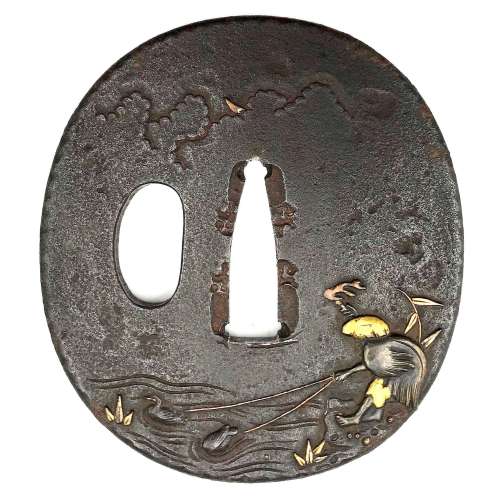

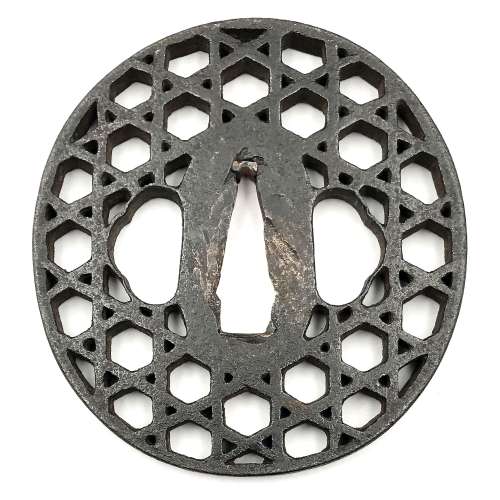
Iron tsuba of oval form decorated with design of jakago (bamboo lattice work) in openwork (sukashi). Copper sekigane.
Unsigned. Edo period.
Size: 73.7 x 70.3 x 5.6 mm.Note regarding design: though some might think that this piece belonged to a member of the lost tribe of Israel, it did not. Jakago baskets were made of bamboo, filled with rocks and used to catch crabs (besides other uses).
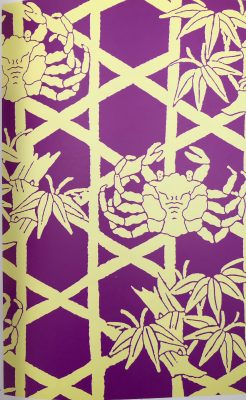
Jeanne Allen. Designer's Guide to Samurai Patterns. Chronicle Books, San Francisco, 1990; p.51, №57.

Large oval form tsuba decorated with two human figures (scholar and attendant) under the pine tree admiring a view of a waterfall on the face of the plate, and with stylized dragons carved on the reverse among the symbols of thunder inlaid in gold. The plate is carved in low relief with details inlaid with gold and silver.
Signed: Yamashiro no kuni Fushimi no ju Kaneie [Kaneie of Fushimi in Yamashiro Province] [山城國伏見住金家], with Kaō. It is a fake signature (
Size: Height: 91.9 mm; Width: 85.6 mm; Thickness: 3.4 mm; Weight: 169 g.
This is a late Edo period, 19th-century export work to cater to the tastes of the European tsuba collectors. It does not have anything in common with the work of great Kaneie masters.
SOLD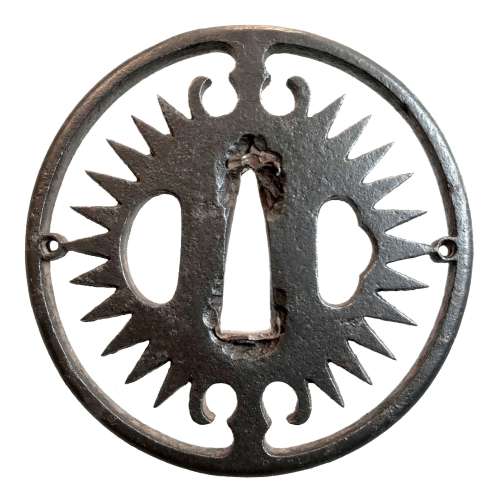
Size: 76.9 x 76.0 x 5.4 mm
For information regarding shakoh tsuba see article 'Kirishitan Ikenie Tsuba by Fred Geyer at Kokusai Tosogu Kai; The 2nd International Convention & Exhibition, October 18-23, 2006, pp. 84-91.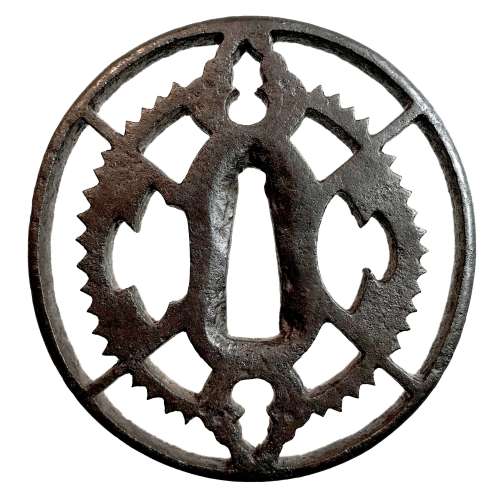
Iron tsuba of oval form pierced with design of slanting rays of light (shakoh), a Christian motif (Jesuit’s IHS symbol), and a pair of tassels in positive silhouette (ji-sukashi). Details on tassels carved in low relief. Traditional description of this kind of design is called “tokei”, or “clock gear”. Rounded rim.
Unsigned.
Edo period, 17th or 18th century. Possibly - Owari school.
Size: 76.0 x 73.0 x 6.2 mm.

Iron tsuba of circular form with the knotted geese (kari) flying over the rough waves pierced (sukashi) and carved in low relief (nikubori). Hitsu-ana plugged with soft metal. Hitsu-ana plugged with soft metal (tin or lead).
Signed: Echizen koku jū Myochin Katsuharu saku.
Edo period.Size: Height: 80.7 mm; Width: 81.0 mm; Thickness: 4.5 mm; Weight: 110 g.
Two tsuba of this master can be found at Georg Oeder Collection (Japanische Stichblätter und Schwertzieraten. Sammlung Georg Oeder Düsseldorf. Beschreibendes Verzeichnis von P. Vautier. Herausgegeben von Otto Kümmel.Oesterheld & Co / Verlag / Berlin, Oesterheld, 1915; LIB-1465 in this collection) under №№ 172 and 173, page 21, though no illustrations. SOLD.
Thin six-lobed iron plate of brownish color is carved on each side with a groove that follows the rim and a concentric grooves around the center of the plate, also carved with six thin scroll lines (mokkō or handles, kan) that follow the shape of the rim. Mokume surface treatment. Hitsu-ana possibly added at a later date, and kogai-hitsu-ana plugged with gold. Silver sekigane.
Signed: Kunihide [國秀]. Higo school, 1st generation swordsmith.
Mid Edo period, ca. 1800.
Would be possibly attributed to Kamakura-bori school revival of the 19th century.
References: Nihon Tō Kōza, Volume VI / Japanese Sword / Kodōgu Part 1, page 231: Enju Kunihide, a tōshō from Higo: "...forging of the jigane is excellent, and there are also pieces with mokume hada."
Haynes Index Vol. 1, p. 741, H 03569.0: "Enju Kunihide in Higo province, died 1830, student of Suishinshi Masahide. Retainer of the Hosokawa Daimyō, etc."
Additional Information from Markus Sesko: This tsuba indeed is made by Enju Kunihide, who in his later years signed the HIDE [秀] character as HI [日] and DE [出], as here: Size: 77.4 x 74.9 x 2.7 mm
Similar pieces are:
1. In this collection № TSU-0341: Kamakura-bori tsuba with mokkō motif. Muromachi period, 15th - 16th century.
2. Dr. Walter A. Compton Collection, 1992, Christie’s auction, Part II, pp. 14-15, №16: “A kamakurabori type tsuba, Muromachi period, circa 1400. The thin, six-lobed iron plate is carved on each side with a wide groove that follows the shape of the rim, and with six scroll lines and a single thin circular groove. […] The hitsu-ana was added at a later date, circa 1500-1550. Height 8.3 cm, width 8.6 cm, thickness 2.5 mm. The tsuba was initially intended to be mounted on a tachi of the battle type in use from Nambokucho to early Muromachi period (1333-1400)”. Sold at $935.
Size: 77.4 x 74.9 x 2.7 mm
Similar pieces are:
1. In this collection № TSU-0341: Kamakura-bori tsuba with mokkō motif. Muromachi period, 15th - 16th century.
2. Dr. Walter A. Compton Collection, 1992, Christie’s auction, Part II, pp. 14-15, №16: “A kamakurabori type tsuba, Muromachi period, circa 1400. The thin, six-lobed iron plate is carved on each side with a wide groove that follows the shape of the rim, and with six scroll lines and a single thin circular groove. […] The hitsu-ana was added at a later date, circa 1500-1550. Height 8.3 cm, width 8.6 cm, thickness 2.5 mm. The tsuba was initially intended to be mounted on a tachi of the battle type in use from Nambokucho to early Muromachi period (1333-1400)”. Sold at $935.
 3. And another one in Robert E. Haynes Catalog #9 on page 24-25 under №23: “Typical later Kamakura-bori style work. This type of plate and carving show the uniform work produced by several schools in the Muromachi </em period. Some had brass inlay and others were just carved as this one is. The hitsu are later. Ca. 1550. Ht. 8.8 cm, Th. 3.25 mm”. Sold for $175.
3. And another one in Robert E. Haynes Catalog #9 on page 24-25 under №23: “Typical later Kamakura-bori style work. This type of plate and carving show the uniform work produced by several schools in the Muromachi </em period. Some had brass inlay and others were just carved as this one is. The hitsu are later. Ca. 1550. Ht. 8.8 cm, Th. 3.25 mm”. Sold for $175.

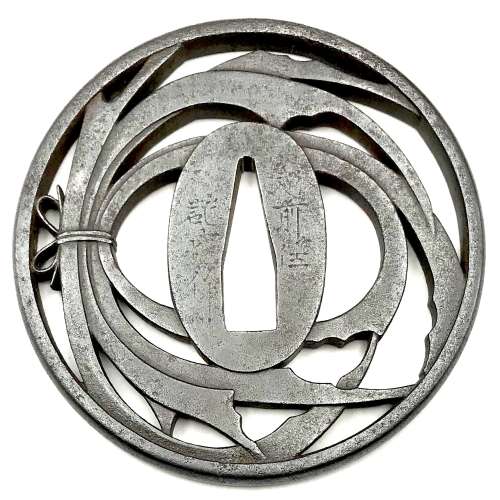
Iron tsuba of round form pierced (sukashi) and carved (marubori) with a 'noshi' decoration design. Noshi - decoration made of dried abalone (awabi) and bearing an auspicious connotation of good fortune, prosperity, etc. Design was used as a family crest (mon).
Size: 76.3 x 75.9 x 5.5 mm.
Signed: Echizen jū Kinai Saku. Kinai school existed from mid 17th to mid 19th century; it is hard to tell which master (generation from 1 to 6) made this particular piece.
SOLD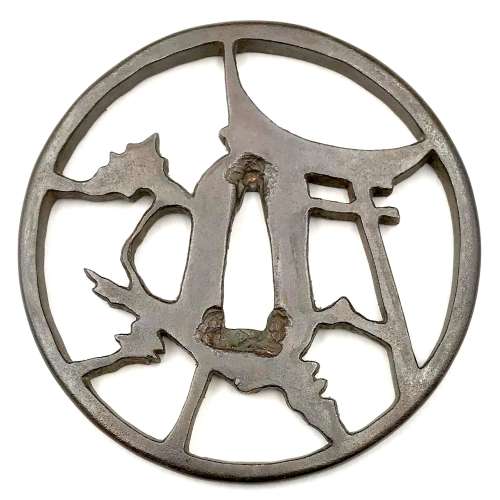
Iron tsuba of round form decorated with the design of distant pines, torii, and crescent moon in openwork (sukashi). Copper sekigane.
Size: 84.9 x 84.8 x 5.8 mm.
Unsigned.
Edo period, ca. 1750.
Tosa Myochin or Akasaka school.Japanese Swords and Sword Fittings from the Collection of Dr. Walter Ames Compton (Part I). Christie's, New York, March 31, 1992, pp. 28-29, № 53:
"A Tosa Myochin School Tsuba. Edo period (circa 1750), signed Toshu ju Kuniyoshi saku. The round iron plate pierced with a design of a temple gate (torii) and a pine tree. It has a round rim and there are some carved details on the surface of the design. The Tosa Myochin school, despite its foundation in the classic Myochin armor school tradition, worked mainly in the style of Akasaka school of Edo. [...] Many are equal to the mid to later Akasaka school work and the two types have frequently been confused. Signed examples are rare. Estimated price $1,500-2,000."
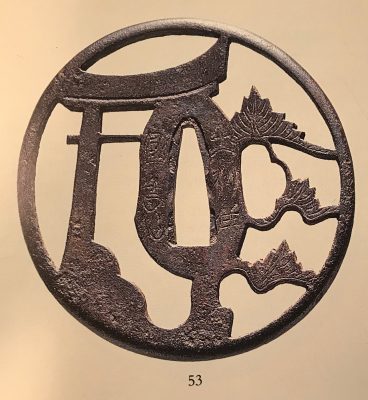
Compton Collection, Vol. 1, №53
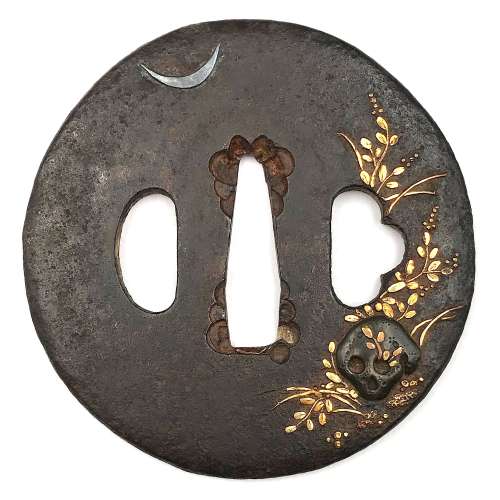

Very fine iron plate well hammered and turned, tapering and rolling to the rounded edge. Tsuba of a cross-form mokko shape (juji-mokko-gata) decorated with spider web inlaid in gold on both sides. The face is carved with a silver-damascened spider holding a gold-damascened butterfly (nunome-zōgan). Kozuka and kogai hitsu-ana of inome (boar's eye) form. The udenuki ana may be of purely decorative purpose.
Signed: Yatsushiro [八代] Jingo Saku [甚吾作], a signature of Chisokutei Amatsune, one of the last Jingo masters.
Late Edo period, Tenpō era, 1830-1844.Size: Height: 77.5 mm; Width: 72.8 mm; Thickness: 4.1 mm; Weight: 141 g.
In a custom wooden box.
Here is what Markus Sesko wrights in his book The Japanese toso-kinko Schools, 2012, on page 374:An artist who worked in the style of the Shimizu-Jingo school was Chisokutei Amatsune (知足亭天常). He was actually a samurai from Yatsushiro who made tsuba as a sideline. An extant old hakogaki of one of his pieces mentions that he died in Edo in the sixth month of An'ei eight (1779) at the age of 73. But the era of An'ei is probably wrong because Chikokutei (sic) is today dated by most experts around Tenpō (1830-1844). His relationships with the Shimizu school or under which Jingo master he had studied are unknown. From the point of view of production time and the finishing of nakago-ana, he is rather associated with the 5th and last gen. Shigenaga who died in the seventh year of Kaei (1854). A peculiarity of Chisokutei was that he signed his Jingo copies with "Yatsushiro Jingo Saku" ([八代甚吾作) but added the small syllable "chi" (チ) or the character "Chi" (知) for "Chisokutei" to identify them as copies.No longer available.

Size: 71.5 x 70.0 x 3.0 mm.

Iron tsuba of oval form with the design of two immortals (Gama Sennin with the toad upon his head and Tekkai Sennin with his iron crutch) beside a waterfall carved in low relief with a high relief effect (takabori) and with details inlaid in gold. A waterfall carved on the reverse. Nakago-ana is plugged with copper sekigane. Unsigned. Allegedly, Mito School.
Edo period, ca. 1700.
Size: Height: 87.0 mm; Width: 82.8 mm; Thickness: 4.4 mm; Weight: 179 g.
No longer available.